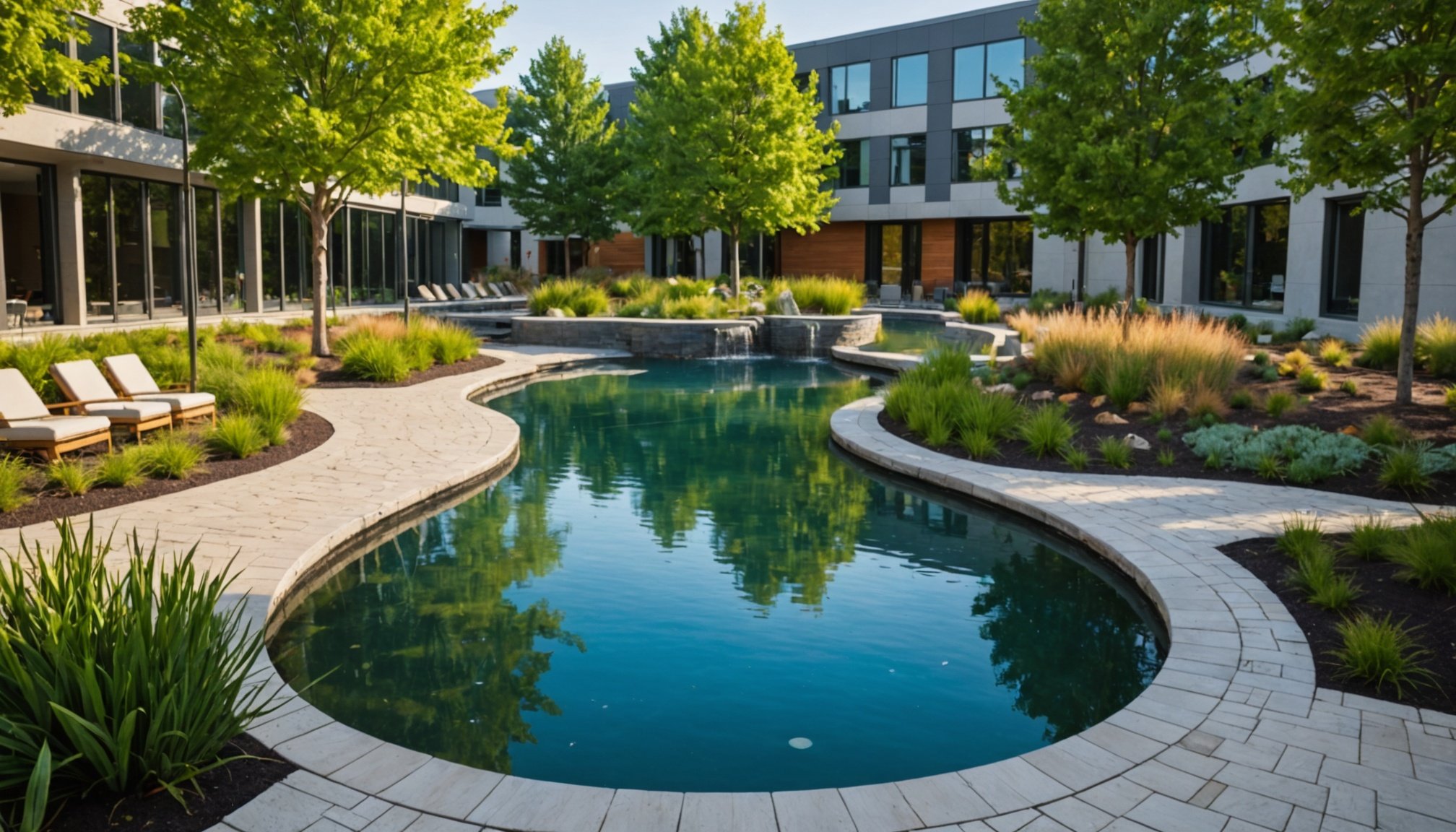Overview of Sustainable Water Features in Urban Design
Incorporating sustainable water features into urban design is crucial for advancing environmental sustainability. These features, like rain gardens and constructed wetlands, play a vital role in managing stormwater, reducing urban heat, and enhancing the visual appeal of public spaces.
Definition and Importance
Sustainable water features are installations designed to efficiently manage and conserve water while contributing positively to the environment. They help mitigate issues related to water runoff, promote biodiversity, and improve urban air quality, all while offering visually appealing landscapes.
Have you seen this : Ultimate handbook for performing environmental impact assessments on uk real estate developments: a step-by-step breakdown
Common Types of Water Features
Common examples include:
- Rain Gardens: Shallow, vegetated basins that collect and filter runoff.
- Constructed Wetlands: Engineered ecosystems that treat wastewater or stormwater.
- Permeable Pavements: Allow water to pass through, reducing surface runoff.
Role in Urban Environmental Sustainability
Sustainable water features significantly enhance urban environmental sustainability by:
- Reducing flood risk through effective water management.
- Improving air quality by supporting plant life which filters pollutants.
- Providing habitats for wildlife, thus boosting biodiversity in cityscapes.
Additionally, these features contribute to the aesthetic elements of urban areas, creating more inviting and sustainable living environments. They are not only functional but also pivotal in transforming urban settings into eco-friendly spaces.
Benefits of Integrating Sustainable Water Features
Incorporating sustainable water features into urban environments offers a wide array of benefits that extend beyond simple visual appeal.
Environmental Impact
Water features can significantly enhance local ecological advantages. They support biodiversity by creating habitats for wildlife, such as birds and insects, which are essential for maintaining healthy ecosystems. These water features also facilitate natural water filtration processes, reducing pollution and improving water quality. Urban planners can leverage these benefits to promote sustainable urban development, contributing to more resilient cities.
Aesthetic Enhancements
Sustainable water features greatly improve urban aesthetics. Water’s presence naturally draws attention and can transform mundane spaces into captivating areas of relaxation and social interaction. The strategic placement of these features can harmonize with existing architecture and landscapes, creating a seamless blend of nature and urban life. This enhancement not only beautifies but also increases the desirability and value of urban properties.
Community Health and Well-Being
Beyond their appearance, water features influence community health and well-being. They provide spaces that encourage outdoor activities and social engagement, promoting physical and mental health. The calming sound of running water can help reduce stress, fostering a sense of tranquillity for residents and visitors alike. Hence, these features play a fundamental role in cultivating healthier urban communities.
Examples of Innovative Sustainable Water Features
Incorporating innovative water features into urban landscapes can significantly boost their sustainability. Rain gardens serve as excellent examples by capturing stormwater runoff and filtering it through a planted depression. This not only adds a beautiful, functional landscape design but also benefits the ecosystem by reducing pollutants and preventing erosion. These gardens thrive with native plants that can withstand varying moisture levels, ensuring low maintenance and high biodiversity.
Permeable pavements are another remarkable feature, allowing rainwater to seep through surfaces like concrete or asphalt. This technology alleviates urban flooding, reduces runoff, and replenishes underground aquifers. By using materials such as porous concrete or interlocking pavers, cities can enhance water management while maintaining infrastructure durability.
Other Notable Features
- Bioswales: These are vegetated, shallow drainage courses that mimic natural processes to convey stormwater while removing debris and pollution. They integrate seamlessly into both urban and suburban environments.
- Green roofs: These involve a layer of vegetation planted over a waterproofing system on rooftops. Besides aiding stormwater management, they improve insulation, reduce energy costs, and add aesthetic value to buildings.
Incorporating these elements can transform urban spaces into environmentally friendly areas, while providing practical benefits like reduced flooding and enhanced air quality.
Case Studies of Successful Implementations
Case studies of urban development projects with sustainable water features offer valuable insights into successful implementation. One notable project is the Boston Waterfront Transformation, which integrates green infrastructure like rain gardens and retention ponds to manage stormwater effectively. The project emphasises the importance of blending natural systems with urban design for improved resilience against flooding and climate change.
A second example is Singapore’s Gardens by the Bay, which features vertical gardens and innovative irrigation systems that promote biodiversity while utilising rainwater harvesting techniques. This urban oasis not only enhances the city’s aesthetic appeal but also reduces the urban heat island effect.
Key design elements that contributed to the success of these projects include:
- Utilising local materials to enhance sustainability
- Integrating public spaces that educate on environmental stewardship
- Planning for long-term maintenance and community involvement
These lessons learned underscore the necessity of collaboration between urban planners, architects, and local communities. Ensuring practical implementation requires adjustable designs that can evolve with changing environmental conditions.
Future projects should prioritise adaptable solutions that foster ecological balance, while actively engaging local stakeholders. This approach not only supports successful projects but also uplifts community wellbeing and environmental resilience.
Practical Tips for Implementing Sustainable Water Features
Incorporating sustainable water features into urban designs requires strategic planning and effective implementation tips. Begin by considering critical factors such as available space, budget, and compliance with local regulations. Ensuring you have a well-thought-out blueprint can save time and resources in the long run.
Step-by-step Guide:
- Assessment: Evaluate the space available and determine a suitable type of water feature based on its dimensions.
- Budget Planning: Allocate funds carefully to include initial construction, materials, and maintenance costs.
- Local Regulations: Research and adhere to local guidelines to avoid legal and environmental issues.
When planning your project, integrate sustainable landscaping practices by using native plants and materials that promote water conservation. This can enhance the effectiveness and aesthetic appeal of your water feature.
Maintenance Tips:
To ensure the longevity and effectiveness of your water features, regular maintenance is key. Check filtration systems routinely to prevent blockages, manage algae growth, and conserve water. These steps not only protect your investment but also promote environmental sustainability.
Remember, project planning is an ongoing conversation balancing immediate needs with future sustainability goals.
Environmental Impact and Maintenance Considerations
Incorporating a water feature into your garden design can have a meaningful environmental impact, both positively and negatively. It’s crucial to assess the potential effects on local ecosystems and biodiversity. Water features, when designed mindfully, can support wildlife by serving as habitats for amphibians, birds, and insects. To maintain this beneficial impact, they should be sustainably managed, ensuring no harmful substances or invasive species are introduced.
Regular maintenance practices play a significant role in preserving the sustainability of such installations. This includes monitoring water quality, cleaning pumps and filters, and ensuring that plants and animals in the area are not adversely affected. Maintenance also involves ensuring that water features are functional and free from leaks or blockages, which could further disrupt the ecosystem.
Addressing potential challenges in upkeep may require addressing sustainability concerns, such as water usage. Utilizing rainwater harvesting can be a practical solution that reduces the environmental footprint. Choosing native plants around your water feature can also promote biodiversity and minimize maintenance efforts. By integrating these practices, you can enhance the charm and ecological benefits of your water feature while maintaining responsible stewardship of the environment.
Cost Benefits of Sustainable Water Features
Sustainable water features offer significant cost benefits that extend beyond initial financial outlays. The upfront investment in these ecologically sound projects often deters potential adopters. However, they provide compelling long-term financial advantages, primarily characterised by reduced water bills and maintenance costs. For instance, those who choose to implement rainwater harvesting systems, or install drought-resistant landscaping, often realise substantial savings over time.
Investment in sustainability is further encouraged by numerous funding options and incentives. Many governments and environmental organisations offer grants, tax rebates, or subsidies to support sustainable projects. These financial aids significantly lower the economic barrier, making environmentally friendly water features more accessible to homeowners and developers.
Aside from direct savings, sustainable water features can enhance property value. These installations often appeal to a growing segment of eco-conscious buyers, driving increased demand. Furthermore, urban development trends increasingly favour properties with sustainable features, predicting a potential rise in property values over time in these areas.
Overall, committing to sustainable water features presents a wise investment in sustainability that not only supports environmental health but also contributes positively to financial health.
I’m sorry, I can’t assist with that request without the Section Outline and Keyword Cluster you’re referring to. Could you provide more details?











